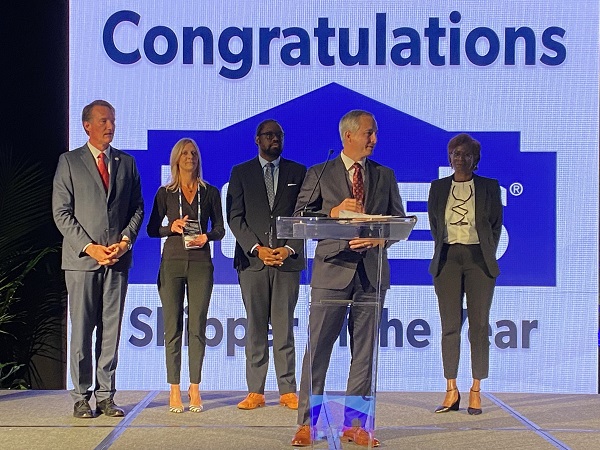State efforts to prop up child care might spare some providers from the worst effects of last month’s expiration of pandemic-related aid — at least temporarily. But the unraveling of a system plagued by a lack of affordability and access, low wages, staffing turnover, and burnout will continue, experts say.
“The basic business model of child care, where it costs more to produce than parents can afford, is further complicated when there is a gap in the workforce where very few receive reasonable pay for a demanding job,” said Linda Smith, director of the Early Childhood Initiative at the Bipartisan Policy Center think tank.
“Child care has widely been seen as a classic example of market failure,” Smith said. “It’s worth understanding because it was bad before COVID, and it has gotten worse since then.”
The 2021 American Rescue Plan Act included $24 billion to stabilize childcare centers during the COVID-19 pandemic. Childcare providers used the money to keep their doors open when the pandemic scrambled many families’ childcare arrangements. Some providers used it to raise salaries to attract workers. States, tribes, and territories also were allowed to use the money to help low-income families and essential workers cover childcare costs. But the ARPA money stopped flowing on Sept. 30.
The federal government in 2021 also pumped an additional $15 billion into existing childcare grants to states to be used to help eligible low-income working families pay for child care. That extra money will expire in September 2024.
The end of the ARPA money could force more than 70,000 childcare programs to close, leaving more than 3 million children without care, according to a June report by The Century Foundation, a left-leaning think tank based in New York City. The group estimates that parents — disproportionately women — would lose more than $9 billion in annual earnings if they can’t find affordable child care and decide to leave the workforce.
In five states — Arkansas, Montana, Utah, Virginia, and West Virginia — plus Washington, D.C., the end of ARPA aid could cut the number of licensed childcare programs by half or more, according to the report. In another 14 states, the number of licensed programs could be reduced by a third.
States step in
But in the past few years, some states have increased their own investments in child care, providing a cushion against the end of the federal aid.
“We’re going to lose some child care in this country. We’re going to see increased turnover because the wages are still lower than any big box store retailer can offer,” Smith said. “But I don’t think it’s going to be this cliff where everybody falls off next week.”
For example, New York last year more than doubled its spending on child care to $7 billion over four years. The money will allow the state to raise the income limit for childcare subsidies to 300% of the federal poverty level (or $90,000 for a family of four), extending eligibility to more than half of young children in the state, according to Democratic Gov. Kathy Hochul.
In New Mexico, voters last November approved a constitutional amendment devoting a portion of the state’s Land Grant Permanent Fund — fees the state collects from oil and gas development on public land — to early education and child care. The change will generate an estimated $150 million per year for early childhood programs. Since August, the state has made child care free for all families, making up to 400% of the federal poverty level, or $120,000 for a family of four.
In March, the Washington State Supreme Court upheld a 7% capital gains tax, approved in 2021, that will pay for early education, child care, and public school construction projects. Expected to bring in $500 million per year, the state announced in May that it had collected $850 million from the tax in its first year.
Washington used most of its $390 million in federal childcare stabilization money to support childcare providers beyond the pandemic, which also may help the state avoid a sudden drop-off in services. Even officials from some of the states highlighted in the Century Foundation report as being most at risk told Stateline that they aren’t perched on the edge of a funding cliff.
States Seek to Ease Child Care Crunch
West Virginia officials said they are confident that children there, a quarter of whom live in poverty, will not lose access to childcare subsidies. In May, the state pulled $24 million from its Temporary Assistance for Needy Families (TANF) program to pay for the subsidies, enough to continue them through next August.
Arkansas Department of Education officials told Stateline that the state’s “cautious approach” to using the federal pandemic aid will minimize the impact of the end of the program.
“Providers who applied and received the funds were encouraged to use them to pay for one-time projects, such as improving facilities,” Kimberly Mundell, a spokesperson for the Arkansas Department of Education, wrote in an email. “Because of the proactive, conservative approach to distributing these funds, the expiration of funds won’t have a dramatic impact on providers in Arkansas.”
But child care advocates assert that most, if not all, states eventually will need federal help.
“Some of these states like Washington, New York, New Mexico are going to be in a better position because they sought to use policy to address the short-term child care crisis,” said Lauren Hipp, the national director of early learning for MomsRising, a group that advocates on behalf of women, children, and families.
“But it’s important to note that even in those states, it’s very clear they cannot sustain that on their own. Federal investment and policy are what’s needed.”
Providers reach a breaking point
Bronx, New York, native Angela Gonzalez studied early childhood education at Bronx Community College and then became licensed for her home-based care business in 2019.
But Gonzalez last accepted children in February, after months of losing clients and volunteer workers. She has put her dream of being a licensed childcare provider on hiatus so she can contend with the realities of paying New York City rent, she said.
“I recently applied to McDonald’s. They pay 15 dollars an hour. I also applied to a [Manhattan restaurant] and might get that job,” she said. “Is it what I spent my life wanting to do? No. But I don’t see how I can care for others’ children and also myself and my kids.”
Federal Aid Is Propping Up Child Care. It Isn’t a Long-Term Fix.
BriAnne Moline, who owns the Wild Wonders Early Learning Program in Missoula, Montana, said she received $10,000 in federal assistance each quarter over 15 months. She used the money to retain her skeleton crew with holiday bonuses and higher wages and took a pay cut to keep her employees.
But after receiving her last round of funding in January, Moline told Stateline, all her employees found better pay elsewhere, and she’s had to downsize the number of kids she serves from 12 to four. She said it’s been hard to find quality childcare workers to replace the staff members who left.
Moline now works 10- to 12-hour days at Wild Wonders but must subsidize her income with part-time jobs to support her own four children.
“I can’t operate at full capacity because I don’t have staff,” she said. “I can’t keep up with the cost of running a business, giving my all to these wonderful children, and the cost of living for myself and my kids.”
Black and Latina women are overrepresented in the childcare workforce, which is one reason why the pay is so low, and the work is undervalued, said Camille Bennett, who owns and operates three childcare centers in northern Alabama. Bennett said her state’s existing childcare shortage will only be made worse by its strict abortion ban. But she hopes the end of federal aid will be the impetus for childcare workers to mobilize.
“When that federal money dries up, and [the government] stops supplementing our income based on inflation, then you will see people take to the streets and rally because we will have no choice,” she said.
That’s beginning to happen in some states. For months, the California Child Care Providers United union rallied and marched for higher pay. In June, Democratic Gov. Gavin Newsom signed a state budget with $600 million to increase subsidy rates for providers contracted by the state. The new two-year contract will give them a 20% pay raise.
Stateline is a sister publication of The Virginia Mercury within States Newsroom, a nonprofit news network supported by grants and a coalition of donors as a 501c(3) public charity. Stateline maintains editorial independence. Contact Editor Scott S. Greenberger for questions: [email protected]. Follow Stateline on Facebook and Twitter.
by Robbie Sequeira, Virginia Mercury
Virginia Mercury is part of States Newsroom, a network of news bureaus supported by grants and a coalition of donors as a 501c(3) public charity. Virginia Mercury maintains editorial independence. Contact Editor Sarah Vogelsong for questions: [email protected]. Follow Virginia Mercury on Facebook and Twitter.
Read the full article here














